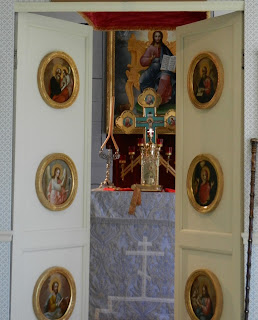 |
| The Bishop's House, Sitka |
The most significant site of interest
in Sitka is without a doubt the Russian Bishop’s House & Museum. Bishop’s House is the oldest intact Russian
building in Sitka, built in 1842 by the Russian-American Company as a residence
for the Bishop of the Orthodox Church.
Although the Bering-Chirikov expedition first arrived in Alaska in 1741,
it was between 1799 and 1867 that the Russian government through the
Russian-American Company maintained colonies in Alaska devoted to the lucrative
fur trade. The Russian Orthodox Church
is the most enduring legacy of this chapter in Alaskan history. The fur trade eventually dwindled and the
Company managers returned to Russia but the Orthodox Church continued to thrive
in Alaska. Bishop Innocent Veniaminov
was a veteran frontier traveler with previous experience in Sitka and the
Aleutian Islands. He was a skilled
craftsman, educator, and had a talent for learning languages. The Russian Bishop’s House was the center
from which he oversaw his far-reaching diocese from Kamchatka, Russian to New
Archangel (Sitka), Alaska. The house
continued in the hands of the Orthodox Church after the 1867 transfer of
Alaska; by the 1960’s the church was overwhelmed with maintenance needs and the
National Park Service purchased the building in 1972 and began a 15-year
project of restoration.
The museum located
on the first floor contains a number of items from this inherited history and
the construction of the building itself is fascinating to see. Portions of the walls, ceilings, and floors
are left uncovered so that visitors can better understand its
construction. Finnish shipwrights employed
by the Russian-American Company were among the craftsmen who built the house. Tightly-fitted squared-logs were used for
framing the house and rooms.
Locking-scarf joints were used for the walls, a shipwright’s method of
joining two timbers to make a longer piece.
Scarf joints remain tight but still allow natural shrinking and swelling
of the wood. Wood filler strips were
used at the log joints to create a smooth interior surface for the wall
finish. A cloth was tacked to the logs
for a wall finish that could be painted or wallpapered. This finish method was used for the ceiling
as well.
Ceiling planks were supported
by slots in walls and ceiling beams held together with dowels. Logs were used for the subfloor with planks
laid above for the main floor. The dead
air space between the subfloor and the floor planks was filled in with sand or
wood chips and shavings for insulation.
The floor was then painted to give a finished look. To reduce the flow of cold air from room to
room, high door sills were used but of course you had to remember to step over
them as well as duck under the lowered doorways. The first floor of the house served as the
church offices; a school for Creole, Aleut, and Tlingit children; and a
seminary where Native clergy were trained.
Today the first floor serves as a museum with historic documents,
photos, and artifacts.
One of the most
interesting and rarest of Russian artifacts is the one and only marker
recovered of 20 known to have been buried.
The inscription on these imperial markers read, ‘Land belonging to
Russia’ and were distributed all along the American mainland from Kodiak Island
to California. Archeologists recovered
the marker at Redoubt St. Michael (located in Norton Sound near the mouth of
the Yukon River) a Russian settlement destroyed by Tlingit Natives in
1802.
The upper floor of the Bishop’s
House still contains some of the original furnishings, and the Chapel still
contains priceless religious icons.
Original furnishings include the sofa and chairs, some small tables, and
Bishop Veniaminov’s writing desk which he built himself and where he wrote and translated religious text. Hanging above the sofa is a painting of Czar
Alexander who emancipated the surfs in 1861.
Several attempts were made on his life and he was finally assassinated in
1881.
The beautiful Chapel still has original icons and has been visited by past leaders of Russia who wept at the sight of these icons.
Many of Russia's religious icons were lost during the Russian Revolution. On the day of our visit to the
Bishop’s House, we were invited to sample Russian tea. Tea was a favorite drink of the Russian’s who
traded Alaskan furs in exchange for Chinese tea shipped back to Russia.
In such remote outposts, trade was necessary
in order to have any luxuries, dishes for example were obtained from trading
with the English ships. I think we
learned more on our second visit to Sitka than we did the first time in
2011. History seems to be one of those
things that grows on you; a bit here and a piece there, until you finally start
to see the bigger picture.
 |
| Tightly-fitted Squared-Log Construction |
 |
| Cloth tacked to the logs for a Smooth Finish |
 |
| Ceiling Construction |
 |
| Floor Construction and Insulation |
 |
| First Floor Museum, Bishop's House |
 |
| Russian Imperial Marker |
 |
| Parlor with painting of Czar Alexander |
 |
| Bishop Veniaminov's Writing Desk |
 |
| Chapel in Bishop's House |
 |
| Chapel, Bishop's House |
 |
| Map of Missionaries, Bishop Veniaminov's Diac |
No comments:
Post a Comment